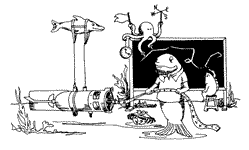
|
The IEEE Seventh Working Conference on Current Measurement TechnologyCurrent and Wave Monitoring and Emerging TechnologiesMarch 13-15 | Bahia Hotel | San Diego, CA, USA |
||
|
Technical Program Accomodations Order the Proceedings Committee and Contact Info |
||
Mooring Motion Bias of Point-Doppler Current Meter Measurements.Paul FreitagChris Meinig NOAA/Pacific Marine Environmental Laboratory Upper-ocean current measurements have been made for more than 20 years from taut-line surface moorings deployed in the equatorial Pacific by Pacific Marine Environmental Laboratory (PMEL). Until 1998 the moorings were instrumented with mechanical current meters (MCMs, either Vector Averaging Current Meters (VACM) or Vector Measuring Current Meters (VMCM)). Comparison with nearby subsurface Acoustic Doppler Current Profilers (ADCP) indicated that differences between the two measurement systems were generally small. Designed in the 1970s, by the early-1990's maintenance of the aging MCMs was difficult, time consuming and expensive. Early tests of the Sontek Argonaut-MD current meters by PMEL indicated that it was a good candidate for replacement of the MCMs. Subsequent comparisons between Argonaut-MD data and that from nearby ADCPs revealed significant bias between the two, with the Argonaut-MD reporting smaller current speed. Further investigation, including the analysis of high-frequency output from the Argonaut-MD compass/tilt-sensor (Precision Navigation model TCM2) and accelerometers, found that the source of the bias was the inability of the compass/tilt-sensor to function properly in response to extreme lateral and rotational accelerations experienced by the instruments. In anticipation of energetic mooring motion, the tilt sensors had been equipped with higher viscosity oil, and the number of compass/tilt-sensor samples had been increased. Finding these modifications insufficient, the instrument firmware was modified so that the tilt sensor was not used in current velocity calculations, but this too proved ineffective. The solution to this problem was to modify the manner of attaching the current meters to the mooring line, which served to decrease the accelerations experienced. Since introducing this modification, differences between Argonaut-MD and ADCP data are comparable to those found previously between MCM and ADCP. Submitted on January 15, 2003 |
|
Sponsored by the Current Measurement Technology Committee (CMTC) of the IEEE Oceanic Engineering Society. All content reserved. Contact jrizoli@whoi.edu for more information. |
||